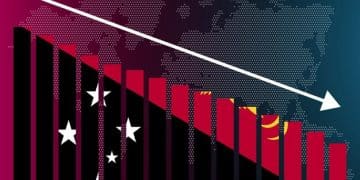The Impact of Interest Rate Hikes on Startup Funding in the US: A 2025 Analysis

The Impact of Interest Rate Hikes on Startup Funding in the US: A 2025 Analysis examines how rising interest rates are expected to affect the availability and terms of funding for startups in the United States by 2025.
Navigating the financial landscape as a startup is challenging, and understanding the forces at play is crucial for survival and growth. One such force is the fluctuation of interest rates. But what does it mean for businesses when these rates increase?
This article delves into the impact of interest rate hikes on startup funding in the US: A 2025 analysis, exploring challenges and opportunities that startups need to prepare for. Join us as we explore this landscape!
Understanding the Current Economic Climate
To fully grasp the implications of interest rate hikes, it’s essential to understand the broader economic climate in which startups operate. Factors such as inflation, economic growth, and central bank policies all play a significant role.
How do these factors influence the funding landscape for emerging businesses?
Key Economic Indicators Affecting Startups
Several key economic indicators can significantly influence the startup ecosystem. Understanding these indicators can help startups anticipate changes in funding availability and adjust their strategies accordingly.
- Inflation Rates: Higher inflation can lead to interest rate hikes as central banks attempt to control rising prices, impacting the cost of borrowing for startups.
- GDP Growth: A slowing or negative GDP growth rate can reduce investor confidence, making it harder for startups to secure funding.
- Unemployment Rates: High unemployment may signal an economic downturn, prompting investors to become more risk-averse and tightening funding conditions.
- Federal Reserve Policies: Decisions by the Federal Reserve regarding interest rates and monetary policy can directly affect the availability and cost of capital for startups.

Moreover, the regulatory environment and geopolitical events can also exert considerable influence on startup funding. Uncertainty in these areas can lead to increased caution among investors and affect their willingness to invest in early-stage companies.
Understanding the interplay of these economic indicators and external factors is imperative for startups to make informed decisions and navigate the complex world of funding.
The Impact of Interest Rate Hikes on Startup Funding in the US: A 2025 Analysis
The impact of interest rate hikes on startup funding in the US: A 2025 analysis reveals several key challenges. Higher interest rates directly increase the cost of borrowing, making it more expensive for startups to secure loans and lines of credit. This can be particularly detrimental to early-stage companies that rely heavily on external funding for growth.
But what are other impacts that affect these emerging businesses?
Reduced Access to Capital
As interest rates climb, the overall availability of capital tends to decrease. Investors may become more risk-averse and shift their focus to more established, lower-risk investments. This can leave startups struggling to compete for a smaller pool of available funds.
What strategies can startups adopt to mitigate the impact of reduced access to capital?
Startups can consider several strategies to mitigate the impact of reduced access to capital:
- Focus on Efficiency: Streamline operations and reduce unnecessary expenses to extend their existing capital runway.
- Explore Alternative Funding Sources: Consider crowdfunding, angel investors, or government grants as alternative sources of funding.
- Build Strong Relationships with Investors: Nurture relationships with existing investors and seek out new investors who are willing to invest in a higher-interest-rate environment.
- Refine Business Models: Adopt more sustainable and revenue-generating business models to reduce reliance on external funding.
Additionally, startups should emphasize transparency and open communication with their investors. Regular updates on key performance indicators and strategic initiatives can help build trust and confidence, making it easier to secure funding in challenging economic times.
By proactively addressing the challenges posed by interest rate hikes, startups can position themselves for long-term success.
Venture Capital Investment Trends
Venture capital (VC) investment trends are significantly influenced by interest rate fluctuations. Historically, higher interest rates have correlated with a slowdown in VC activity as investors seek safer, more stable returns.
How can startups adapt their funding strategies to effectively engage with venture capital firms in this evolving landscape?
Shifts in Investment Focus
Interest rate hikes can lead to a shift in the investment focus of venture capital firms. VCs may become more selective, concentrating their investments in companies with proven business models and strong revenue streams.
What are the specific sectors and industries that may attract increased VC interest during periods of rising interest rates?
During periods of rising interest rates, venture capital firms may gravitate towards sectors and industries that demonstrate resilience and growth potential, such as:
- Healthcare Technology: Companies developing innovative solutions to improve healthcare delivery and reduce costs are often seen as defensive investments during economic uncertainty.
- Cybersecurity: With the increasing prevalence of cyber threats, cybersecurity companies are likely to attract continued VC interest.
- Financial Technology (Fintech): Fintech companies that offer efficient and cost-effective financial services may benefit from increased demand in a higher-interest-rate environment.
- Renewable Energy: As the world transitions towards sustainable energy sources, renewable energy companies are expected to remain attractive to venture capital investors.

Startups in these sectors should highlight their unique value propositions and demonstrate their ability to generate sustainable returns. Building a strong team, establishing a solid track record, and articulating a clear path to profitability can significantly enhance their appeal to venture capital investors.
In conclusion, as venture capital investment trends shift amidst interest rate fluctuations, startups must adapt their strategies to attract and secure funding in a more competitive market.
Alternative Funding Options for Startups
Given the challenges posed by interest rate hikes and reduced access to traditional funding sources, startups should explore alternative funding options to diversify their capital base and enhance their financial resilience.
What are some innovative and less conventional approaches to funding that startups can leverage?
Crowdfunding and Angel Investors
Crowdfunding platforms offer startups the opportunity to raise capital from a large number of individuals who contribute relatively small amounts. This approach can not only provide funding but also generate early customer engagement and market validation.
In the other hand, angel investors are high-net-worth individuals who invest their own capital in early-stage companies. They often bring valuable experience, mentorship, and networks to the table.
Startups seeking to leverage crowdfunding and angel investors should consider the following:
- Craft a Compelling Story: Clearly articulate the startup’s mission, vision, and value proposition.
- Engage Your Audience: Build a community around the startup by actively engaging with potential investors and customers.
- Offer Attractive Incentives: Provide rewards or equity in exchange for contributions.
- Leverage Social Media: Use social media platforms to promote the crowdfunding campaign or attract angel investors.
Government grants and subsidies represent another important funding avenue for startups, particularly in sectors aligned with national priorities such as technology, healthcare, and sustainability. These grants typically do not require equity dilution and can provide significant financial support for research, development, and commercialization efforts. By exploring and strategically leveraging these alternative funding options, startups can enhance their financial stability and ensure continued growth despite the challenges posed by rising interest rates.
Strategies for Navigating Interest Rate Hikes
To navigate the challenges posed by interest rate hikes, startups should adopt proactive strategies to optimize their financial management and build resilience. This includes focusing on efficient capital allocation, revenue diversification, and cost reduction.
How can startups effectively balance growth aspirations with the need for financial prudence during periods of rising interest rates?
Building Financial Resilience
Building financial resilience is crucial for startups to weather the storm of interest rate hikes and economic uncertainty. This involves implementing sound financial management practices, maintaining a healthy cash flow, and diversifying revenue streams.
Building financial resilience:
- Optimize Capital Allocation: Prioritize investments that generate the highest return and align with the startup’s strategic objectives.
- Diversify Revenue Streams: Reduce reliance on a single source of revenue by exploring new markets, products, or services.
- Reduce Costs: Identify and eliminate unnecessary expenses to improve profitability and cash flow.
- Maintain a Healthy Cash Flow: Closely monitor cash inflows and outflows to ensure sufficient liquidity.
Moreover, startups should consider hedging against interest rate risk by entering into fixed-rate loan agreements or using interest rate swaps. Building strong relationships with lenders and investors is also essential, as it can facilitate access to capital and favorable financing terms. In conclusion, by implementing these comprehensive strategies, startups can effectively navigate interest rate hikes and build a foundation for long-term financial stability.
| Key Point | Brief Description |
|---|---|
| 🔥 Interest Rate Impact | Rising rates increase borrowing costs for startups. |
| 💰 VC Trends | VCs shift to safer investments, impacting startup funding. |
| 💡 Alternative Funding | Crowdfunding, angel investors, & grants become crucial. |
| 💪 Financial Resilience | Efficient capital use and cost reduction are key. |
Frequently Asked Questions
Rising interest rates may cause venture capital firms to become more risk-averse, preferring investments in established companies over startups, thus reducing available funding.
Startups can explore crowdfunding, angel investors, government grants, and strategic partnerships as alternative funding options to diversify their capital base.
Startups should focus on efficient capital allocation, cost reduction, revenue diversification, and maintaining a healthy cash flow to mitigate the impact of rising interest rates.
Sectors like healthcare technology, cybersecurity, fintech, and renewable energy are often considered defensive investments and may attract increased VC interest.
Early-stage companies that heavily rely on external funding may find it more challenging to secure loans and lines of credit due to higher borrowing costs.
Conclusion
In conclusion, the impact of interest rate hikes on startup funding in the US: A 2025 analysis presents both challenges and opportunities for startups. By understanding the economic climate, adapting funding strategies, and building financial resilience, startups can navigate these turbulent times and position themselves for long-term success.
The ability to adjust, innovate, and maintain financial discipline will be key determinants of which startups not only survive but thrive in the evolving financial landscape.





